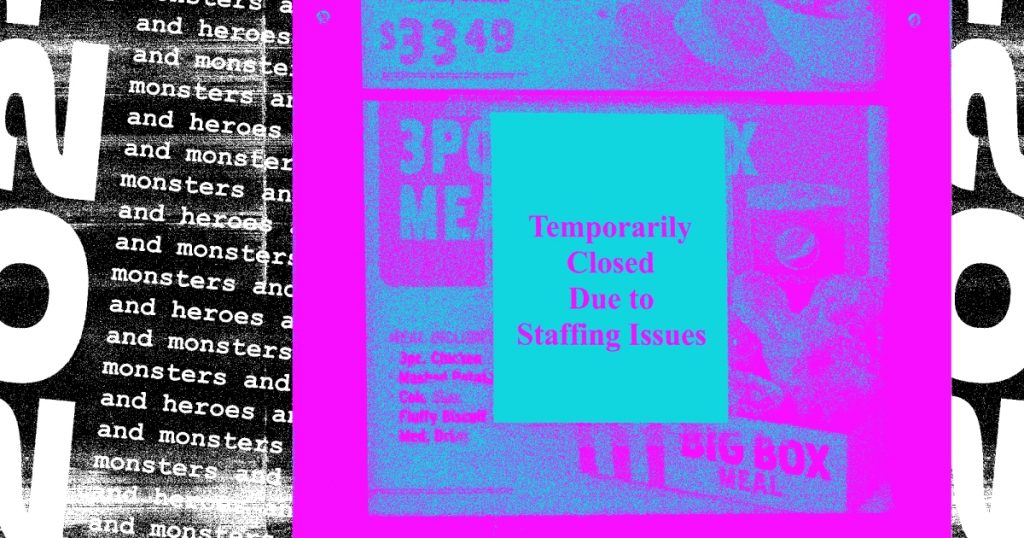Monsters: Those “Nobody Wants to Work” Signs
Mother Jones illustration; David Zalubowski/AP
Fight disinformation. Get a daily recap of the facts that matter. Sign up for the free Mother Jones newsletter.As usual, the staff of Mother Jones is rounding up the heroes and monsters of the past year. Find all of 2021’s heroes and monsters here.
Sonic in Albuquerque says “No one wants to work anymore.” pic.twitter.com/CR128n60mM
— Patrick Hayes (@ABC15Patrick) April 14, 2021
Chances are you’ve seen that sign in the window of some restaurant or coffee shop in your local downtown. Maybe it was written even more nicely:
Sign in a Subway in North Carolina admitting that under the Biden administration no one wants to show up for work. pic.twitter.com/NiasZyRHw7
— Suzanne Bird (@pearlskylar1) July 14, 2021
But the gist is always the same. A local coffee shop or restaurant or fast-food joint can’t be open to serve you, the loyal customer, because people are just too lazy to work.
These businesses are the worst. They could say Now closed on Mondays or New hours: closing at 4 p.m.—that’s cute, almost European. Instead, they blame supposedly lazy workers for not working hours that were probably unsustainable even before the pandemic. They’re putting up a giant advertisement that they are simply crap bosses. It’s not that nobody wants to work. Nobody wants to work for you.
The pandemic has caused Americans of all professions to reevaluate their priorities and how they want to work. Some have learned new skills in quarantine that have led to higher-paying work; others—many who couldn’t have imagined it in February 2020—now find themselves serving as unpaid primary caregivers or homeschool teachers.
The service and hospitality industry is supposedly one of those struggling hardest to find workers—and the likeliest to flaunt one of those dastardly signs. It’s also an industry notorious for its bullying bosses, unstable hours, lack of benefits, and, above all, awful pay. Restaurants are allowed to pay tipped workers (i.e., servers) far below the minimum wage in most states. Over the summer, when I was unemployed, I applied to a handful of restaurants. All had put out desperate hiring pleas, and yet were only offering the tipped minimum: in Maryland, that’s $3.83 an hour. The state minimum wage is $11.75. The same restaurants wanted at least 30 hours of availability a week. No benefits, no health insurance, no 401(k).
Are workers lazy for not wanting to work under these conditions, or have they just had enough?
While unemployment, according to the Bureau of Labor Statistics, hasn’t quite fallen to pre-pandemic levels, it’s declined pretty steadily since the first shutdowns in March and April 2020. It kept dropping as industry groups pushed to suspend federal unemployment benefits. It’s hard to find evidence that Americans don’t want to work.
Businesses aren’t owed workers; supply and demand applies to labor, too. If you can’t pay market rate, no one owes you a discount. If you won’t pay market rate, buddy, that sounds like a you problem. Does your restaurant offer everyone on tipped minimum a strip steak for three bucks and change?
Lastly, and most importantly, signs that blame low-wage workers for staffing issues perpetuate dangerous misconceptions. The idea that underpaid workers are “lazy” or “don’t want to work” has real consequences when legislatures are deciding whether to shrink or expand social welfare programs. The working poor suffer when housing benefits or food programs are cut because politicians and the ruling classes view them as “lazy” and undeserving.
By all means, put up a NOW HIRING sign, but don’t blame workers for your inability to keep up. Sorry for the inconvenience.





